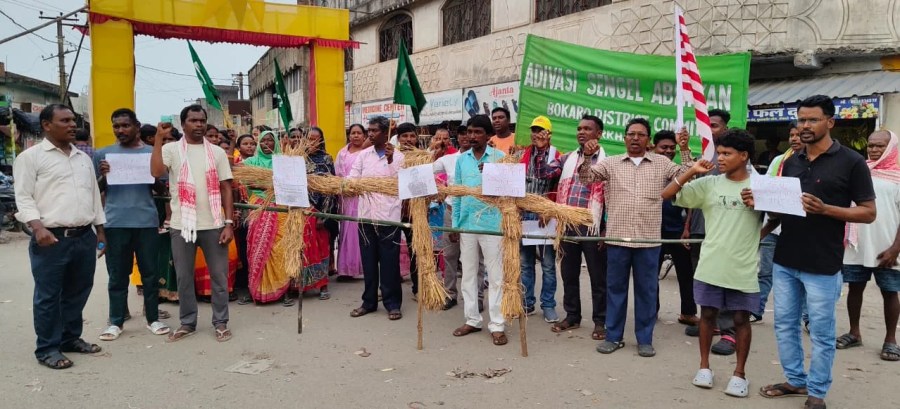Jharkhand became the epicenter of a heated tribal identity protest as the Adivasi Sengel Abhiyan organization burnt effigies of political leaders, including Chief Minister Hemant Soren, in Bokaro’s Tupkadih area.
A strong protest was staged by the Adivasi Sengel Abhiyan at Tupkadih Chowk today in Jharkhand, where effigies of tribal leaders supporting the inclusion of the Kurmi/Mahto community in the Scheduled Tribe (ST) list were burnt.
The demonstration was led by Bhim Murmu, the Bokaro district coordinator of the Abhiyan. Addressing the gathering, Sukhdev Murmu, President of Adivasi Sengel Abhiyan (Bokaro) and Bokaro Zonal Head, stated that on September 20, 2025, the Kurmi/Mahto community had launched a “Rail Roko” (stop trains, block roads) movement, claiming ST status. He asserted that the Kurmi/Mahto community is not tribal by any measure and accused them of seeking ST status to usurp the rights and benefits meant for genuine Adivasis.
Murmu cited Article 342 of the Indian Constitution, which empowers the President and the Parliament to include any community in the ST list, but only through a prescribed constitutional process. He emphasized that communities like Santal, Munda, Oraon, Kharia, Paharia, Bhumij, and Birhor were recognized as tribes even before the creation of the ST list in 1950, based on their distinct language, culture, and way of life, which persist today.

He expressed regret that certain communities are now aggressively seeking ST status solely for reservation benefits, which he claimed would destroy the rights, language, and culture of existing Adivasis. He accused Kurmi-Mahto leaders and workers of being shamelessly engaged in this campaign. Furthermore, he highlighted the contradiction that while the Kurmi-Mahto community demands ST status, its representatives have opposed tribal-centric laws like the PESA Act, 1996, in assemblies and parliament.
Jharkhand State Coordinator, Karamchand Hansda, blamed the Jharkhand Mukti Morcha (JMM) party for supporting this demand. He alleged that for the sake of vote bank politics, JMM leaders have signed recommendations, inviting a volatile situation akin to that in Manipur. He specifically pointed out that on February 8, 2018, 42 MLAs and 2 MPs, under the leadership of the current Chief Minister Hemant Soren, signed a recommendation to the central government to include Kurmi-Mahtos in the ST list, thereby providing “oxygen” to their demand.
Consequently, the protestors burnt effigies of Chief Minister Hemant Soren, 28 current tribal MLAs (including names like Basant Soren, Louis Marandi, Hemlal Murmu, etc.), two tribal MLAs from general seats (Babulal Marandi, Kalpana Soren), and the 42 MLAs and 2 MPs (Vidyut Varan Mahato, Ramtahal Choudhary) who had signed the 2018 recommendation.
The crowd chanted slogans like “Hemant Soren, come to your senses,” “Down with Hemant Soren,” and “Stop making Kurmi-Mahtos tribal.” They warned that if the tribal MLAs and MPs do not cooperate in saving the tribal community, their residences would be gheraoed (surrounded).
The effigy burning event saw participation from dozens of men and women, including Gopinath Murmu, Anand Tudu, Saraswati Hansda, Anita Kisku, Savitri Murmu, Upendra Hembram, and many others.

Key Points of the Protest:
Demand: A clear statement from CM Hemant Soren on his stance and a withdrawal of support for including Kurmi/Mahtos in the ST list.
Organizer: Adivasi Sengel Abhiyan
Action: Burning of effigies of pro-Kurmi/Mahto ST-status leaders and politicians.
Primary Allegation: The Kurmi/Mahto community is not genuinely tribal and is seeking ST status for reservation benefits, which would harm existing Adivasi communities.
Accused: Kurmi/Mahto leaders and the JMM party, especially Chief Minister Hemant Soren and other MLAs/MPs who recommended the inclusion.
FAQs
1. Why are Adivasi groups protesting against the Kurmi-Mahto community’s demand for Scheduled Tribe (ST) status?
Adivasi groups, led by the Adivasi Sengel Abhiyan, are protesting because they believe the Kurmi-Mahto community does not meet the historical, cultural, and constitutional criteria to be classified as a Scheduled Tribe. They accuse the Kurmi-Mahto community of seeking ST status solely for reservation benefits, which would dilute the rights, quotas, and protections meant for genuine Adivasi communities. They also point out that while demanding ST status, Kurmi-Mahto representatives have historically opposed pro-tribal laws like the PESA Act, 1996.
2. Which political leaders and parties are being blamed for the controversy?
The protestors have squarely blamed Jharkhand Chief Minister Hemant Soren and his party, the Jharkhand Mukti Morcha (JMM). They refer to a specific event on February 8, 2018, when then-CM Hemant Soren led 42 MLAs and 2 MPs in signing a recommendation to the central government to include the Kurmi-Mahto community in the ST list. The protestors see this as a political move for vote bank politics that betrays the Adivasi community.
3. What is the constitutional process for including a community in the Scheduled Tribe list, and what is the protestors’ main argument?
According to Article 342 of the Indian Constitution, the President of India, in consultation with the Governor of a state, has the power to specify the tribes or tribal communities deemed to be Scheduled Tribes. This is done through a public notification, which can later be modified by Parliament.
The protestors’ main argument is that communities like Santal, Munda, and Oraon were recognized as tribes because of their distinct and historically separate language, culture, and way of life, which existed long before the official list was created in 1950. They insist that any new inclusion must follow this strict constitutional principle of distinct identity, not just political expediency.

